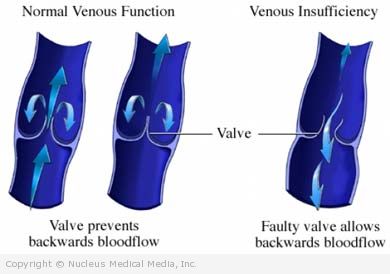Chronic venous insufficiency
Chronic venous insufficiency – Definition
Chronic venous insufficiency is caused by higher-than-normal blood pressure within the leg veins. This may be due to blood clots or phlebitis (swelling and inflammation of the veins). Blood clots in the legs (called deep vein thrombosis) can damage the valves in the veins. When people get chronic venous insufficiency after a blood clot, it may be referred to as post-thrombotic syndrome. When it occurs after phlebitis, it may be referred to as postphlebitic syndrome.
Chronic venous insufficiency – Causes
Chronic venous insufficiency can be caused by blood clots, which can damage the valves in the veins.
Other causes of chronic venous insufficiency include:
- Congenital (inherited at birth) absence or weakness of valves in the leg veins
- Increased venous pressure in the legs for any reason
- Varicose veins
Chronic venous insufficiency – Risk Factors
A risk factor is something that increases your chances of getting a disease or condition.
Risk factors for chronic venous insufficiency include:
- Obesity
- Physical inactivity
- Increased age (50 and over)
- Sex: female
- Family members with deep vein thrombosis or varicose veins
- Smoking
- Pregnancy
- Chronic constipation
- Regularly sitting or standing for long periods of time
- Wearing restrictive clothing such as very tight girdles or belts
Chronic venous insufficiency – Symptoms
When blood pools in the legs, it puts pressure on the veins. Sometimes the blood leaks out into the tissues, discoloring and damaging the skin, and even causing skin ulcers. Symptoms of chronic venous insufficiency can include:
- Swelling of the legs
- Pain in the legs (especially after walking), including:
- Aching
- Dullness
- Tiredness
- Cramping
- Darkening of the skin on the legs (reddish or brown)
- Varicose veins
- Ulcers on legs, especially around the inside of the ankles
- Scaling skin on legs
- Hard, leathery skin on legs
Chronic venous insufficiency – Diagnosis
The doctor will ask about your symptoms and medical history and perform a physical exam. If the diagnosis is not clear from the exam or you are considering surgery, you may also have the following tests:
- Duplex scanning (venous ultrasound/ Doppler) — An ultrasound is a test that uses sound waves to examine the inside of the body. In this case, the blood flow in the veins in your legs is evaluated and the presence of a clot can be detected.
- Venogram (x-ray of the veins) — An x-ray is a test that uses radiation to take a picture of structures inside the body. In this case, dye will be injected into a vein in your foot, and several x-rays will be taken.
Chronic venous insufficiency – Treatment
Once the valves have been damaged, they usually cannot be repaired. Treatment is ongoing and is aimed at maintaining blood flow and preventing pooling of blood. Treatment involves the following:
- Elastic support — Your doctor will prescribe special elastic stockings that squeeze the veins in the legs and keep the blood from pooling.
- Elevation — Raise your feet and legs above the level of your heart while resting or sleeping. Your doctor may ask you to do this several times a day.
- Exercise — Your doctor may encourage you to walk and to do specific exercises for your legs and feet.
- Mineralbath therapy (balneotherapy) — This treatment may help to improve symptoms, even in advanced cases of chronic venous insufficiency.
- Movement — Avoid long periods of sitting or standing. If you go on an extended trip, get up and walk or flex your leg muscles every 30 minutes or so.
- Skin care — If you have a skin ulcer, your doctor may use bandages (Unna boots) and/or apply an antibiotic cream to help prevent infection. Wearing compression stockings may also promote healing.
- Sclerotherapy — This treatment involves injection of a caustic material into the malfunctioning veins. Scar tissue fills the veins, and the blood is rerouted through other, more functional veins. Over time, your body will resorb the vein.
- Ablation — A tiny electrode is inserted into the malfunctioning vein, and electricity/heat scars the vein, blocking it off. As with, sclerotherapy, your body will resorb the nonfunctional vein over time.
- Surgery — Surgery is reserved for the few cases where discomfort or ulcers do not respond to conservative treatment. The type of surgery recommended will depend on your particular reason for having this condition, and the results of testing. Some possibilities include:
- Valve repair
- Vein stripping — This involves the removal of the faulty vein.
- Bypass surgery — A new length of artificial vein (a graft) is connected to two areas of the malfunctioning vein, in order to allow the blood flow to bypass the area that is not working.
Chronic venous insufficiency – Prevention
To help prevent chronic venous insufficiency, take steps to decrease your risk factors. These include:
- Maintain a healthful weight.
- Exercise regularly.
- If you smoke, quit.
- Avoid prolonged standing or sitting.
- Avoid wearing restrictive clothing such as very tight girdles or belts.

